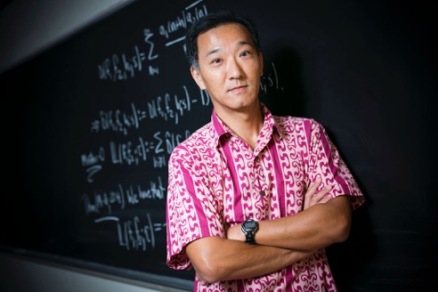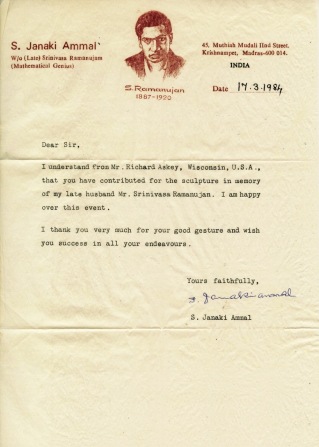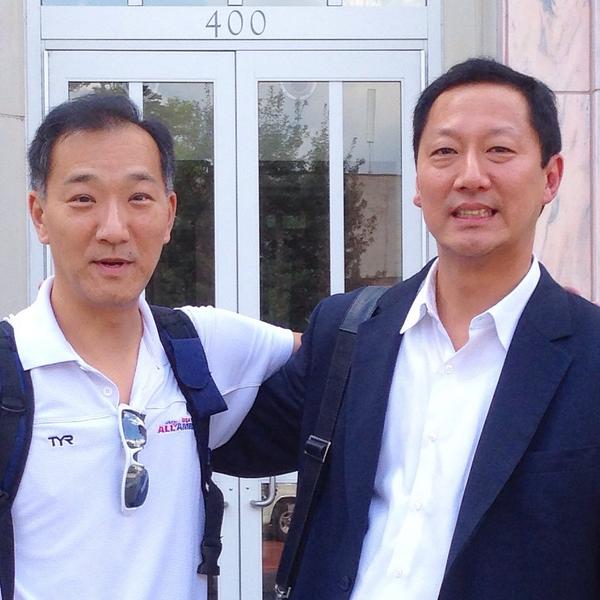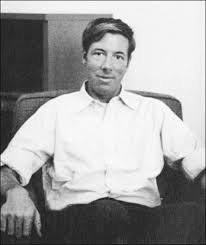Ken Ono is the Asa Griggs Candler Professor of Mathematics and Computer Science at Emory University. His highly accomplished research program focuses on number theory, algebra, and combinatorics. Ken graduated from UCLA with his doctorate of mathematics in 1993. Before joining Emory in 2010, he has held several academic positions including one at the Institute for Advanced Study at Princeton.
Ken received great recognition for his scholarship. His many awards and recognitions include a Sloan Fellowship, a Packard Fellowship, Guggenheim Fellowship, Presidential Career Award, National Science Foundation grants, and the National Science Foundation Director’s Distinguished Teaching Scholar Award. He is also a fellow of the American Mathematical Society.
Apart from his mathematical work, Ken has been active in various media productions. Most notably he was associate producer and consultant for the movie The Man Who Knew Infinity based on the life of Ramanujan. See my review from TIFF 15. The the featured image of this blog, where Ken is discussing mathematics with Dev Patel (who played Ramanujan in the film).

Ken has a great life story, which was highly influenced by the legendary mathematical genius Ramanujan. It’s not everyday you meet a top mathematician who was a high school drop out. There are some wonderful life lessons there for all of us here.
Enjoy!
AB: When did you first realise you had a talent and interest for mathematics?
KO: Those are really two different questions. I recognised that I had math talent in first or second grade. My parents like to tell the story that I independently discovered the proof that there are infinitely many primes when I was in second grade. I can’t vouch for that.
For as long as I can remember, I was told I was good at mathematics. I didn’t really love mathematics until my early twenties.
AB: In your recent book My Search for Ramanujan you chronicle the struggles that led you to a career in mathematics. For those who haven’t read the book, would you describe some of the background leading up to your doctoral work in mathematics?
KO: My parents came to the United States in the 1950s. My father got a job as a member at the Institute for Advanced Study. He was invited by André Weil. Try to imagine their circumstances. My parents, both Japanese, were brought up in an environment where they were told that their emperor was a god. They were told that their race was superior to the Americans. It was difficult for all Japanese at the time to face the reality that this is absolutely false. How do people like my parents recover from all that?
My parents were not embraced when they came to the US. In fact, there were terrible things that happened to them because they were Japanese—they were considered the enemy. And it was difficult for them to raise three boys in a country they were taught to hate. My parents thought that the only way for us to succeed was for us to be great mathematicians or scientists or musicians. They prohibited us from doing anything that was normal. They were uber-Tiger parents.
My book begins with how it was difficult to live under these circumstances. I grew to hate math. I knew I was good at it, but by the time I was in high school, I hated math as it represented everything I did not want to be. It represented not having freedom. I couldn’t hang out with friends. I wasn’t even allowed to have friends.

It was a very long road. A large part of my book is about coming to term with my parents. I love my parents. I only understand them now after having spending a lot of time imagining what it would have been like to be them, raising three boys in a country they were afraid to live in. They did their best. However, opinions changed over time. We are no longer discriminated against by the time I was in grade school. The atrocities my parents suffered when they first came to the US were so extreme that even to this day they lock themselves in their house.
I’m the youngest of three boys. By the time I was in elementary school, I didn’t know about any of this. All I knew was my life with my brothers in our small nuclear family. We were on our own, locked in our house in isolationist Japan…going to school in America.
Ramanujan helped me at basically every critical point in my life. I am a high school dropout. In the 10th grade, I was planning on dropping out of high school to run away from home and never see my parents again—that’s how stifling it was. On April 7, 1984, when I was in tenth grade, a letter came to the house from India. It was from an Indian woman I never heard of called Janaki Ammal (who was Ramanujan’s widow). She thanked my dad, who was one of eighty mathematicians who made a contribution to help pay for the statue of some Indian guy who died in 1920. He broke down after reading this letter. He then told me the story of this legendary mathematician Ramanujan whose ideas came to him in visions from a goddess.

All I could hear was my dad was looking up to a two-time college drop out as a hero. Maybe if I don’t get perfect college admissions test scores, they wouldn’t kick me out of the house! Maybe there was a path for reconciliation.
So I used the letter against my parents saying it was unreasonable for them to demand their kids to be perfect students. I threw Ramanujan back in their faces thinking it would be a source of more arguments. To my surprise, it worked. He said if you need time off (and this was before anyone talked about gap years), then drop out of high school and go find yourself. But he asked to do it in a safe way, and go live with your brother Santa who is a graduate student in Montréal. A few weeks later, I was living with my brother in Montréal enjoying my freedom.

I never understood why my dad let me go, until 1997. I went to the University of Chicago. It was easier to get into college then than it is now. Chicago had a program that admitted kids without high school diplomas. I had test scores off the charts. A psychologist at Johns Hopkins had been studying me since I was five years old. His name was Julian Stanley. He was very famous. He wrote a letter of recommendation for me that got me into the University of Chicago. Without that, I don’t know what would have become of me.
I was a terrible student at the university, majoring in Greek life. By the time I was a senior, I was struggling with a 2.7 GPA. I wanted to be pre-med—that didn’t last long. I was really lost.
In the summer of 1988, I was flipping through the channels on television, and came upon a NOVA special on Ramanujan. I hadn’t thought about him in four years. On television, in color, was the story of Ramanujan. I was transfixed by it. Had it not been for that accidental evening flipping channels, I might have worked for a bank. Instead, I thought about what Ramanujan did for me as a tenth grader, and I found hope again in his story. After much soul-searching, I decided to make the most of my very last year of college.
Beforehand, I didn’t go to class, and if I did go, I sat in the back row and wanted to be anonymous. That was hard to do, as my father who was a math professor and had many friends at the University of Chicago. I did the minimal amount of work to pass.
I took one class from Paul Sally, which was a graduate class in analysis. I tried and did very well. By the end of the first quarter of my senior year, he called me into his office and said that he wanted to make a covenant with me as he had figured me out. Paul Sally had an interesting story of his own: he started as a taxi cab driver. He took Ray Kunze at Brandeis University to the Boston Logan airport, and that was how he was discovered. When he was my age he wanted to play basketball, and that he figured me out. He said I was talented, and that I should go to graduate school. We made a deal, and Sally made some calls. He got me into top graduate programs despite my 2.7 GPA.

In graduate school at UCLA, I had a great advisor Basil Gordon. We read The Man Who Knew Infinity together. I became a mathematician because Basil taught me to see beauty in mathematics and I haven’t turned back since.

Ramanujan helped me seek my own life at sixteen, and when I was in college it woke me up to the fact that I should forge a life for myself, not just continue to be angry with my parents. As a professional mathematician, I have been following some of the paths he has left behind.
Ramanujan was an unexpected guardian angel. Every time he entered my life, something amazing happened. And most recently there was the film The Man Who Knew Infinity. If Matt Brown hadn’t made this film, my life would have been different.
AB: You were a consultant on the excellent Ramanujan biopic The Man Who Knew Infinity. How did you get involved in the film? What was your experience working on the movie?
KO: It was June 2014 and I got an e-mail from Matt Brown about his film project The Man Who Knew Infinity. They were in Pinewood Studios getting ready for filming. The next day I Skyped with Liz Colbert who was the art director for the film, and she wanted to talk about the props. What was supposed to be a fifteen minute introduction turned into a three-hour chat. Matt realised I knew the story so well that I could be useful on set.

A few days later I flew to London not only to help with the art but the final tweaking of the script. I also helped with the rehearsals with Dev Patel and Jeremy Irons. I ended up being promoted to Associate Producer. Now I’m in the film business, and I’m having the time of my life.

AB: There is a great photo of you explaining mathematical concepts to Dev Patel on the set of The Man Who Knew Infinity. What was that experience like? Do you think he grasp the mathematics involved?
KO: We were rehearsing scenes on Hardy’s work with Ramanujan on the partition function, where they were trying to obtain an asymptotic formula. If you asked him today, Dev could probably recall the partition numbers, and that they grow incredibly fast. He could also tell you that Ramanujan and Hardy figured out a formula that nearly gives the correct answer. Anything beyond that he didn’t understand, but time was limited. Our goal was to get the spirit of the work right. And I think he did a great job.

AB: There is a burgeoning interest among the public to watch movies and read biographies about theoreticians like Ramanujan, Hardy, Turing, Hawking, and so on. Why do you think the people are interested in mathematicians and their stories?
KO: There are two projects in the works involving Nicolai Tesla and Emmy Noether. A good screenwriter can make a movie out of any interesting person. With the success of A Beautiful Mind and Good Will Hunting, the idea of making movies about mathematicians was in the air.
You have to have producers and financiers who are willing to underwrite these projects. That was the main obstacle for decades. Great actors are also trying to put capstones in their careers. That’s how we got Jeremy Irons. He’s played Alfred the butler, and the priest in The Mission, but he wanted to play the role of a Cambridge don. Hardy was perfect for the role.
AB: Your research focuses on a number of topics such as number theory, combinatorics, and algebra. In broad terms, can you describe the goals of your research program?
KO: Early in my career I focused on number theory. I focused mainly on classical number theory, like the theory of partitions that Ramanujan studied. I was also interested in elliptic curves and the Birch and Swinnerton-Dyer conjecture. I haven’t thought about those topics in a long time, although many of my students still work in those areas.
More recently I’ve been thinking about the objects I study in number theory, and their role in representation theory, string theory, and mathematical physics. We recently proved the Umbral Moonshine Conjecture, which is at the interface of number theory, physics, and representation theory. Most of my work is now are related to these questions.
Earlier this year with Kannan Soundararajan at Stanford and Ma and Jin, we proved the Riemann Hypothesis for modular form periods, and we are proud of that result. Most of my time now is focused on moonshine and representation theory.
AB: How did you come to solve the Umbral Moonshine Conjecture?
KO: Here is Ramanujan again. It’s unbelievable.
John Conway and Simon Norton noticed decades ago that the coefficients of the modular j function seemed to resemble the degrees of the irreducible representations of the monster group (the largest of the finite simple sporadic groups). This came at the time before the completion of the classification of the finite simple groups.
Conway and Norton assembled a precise theory which showed that the representation theory of the monster group is completely encoded by a special class of modular functions. Later, Richard Borcherds proved this conjecture by constructing an infinite dimensional monster Lie algebra that makes all of this precise. He went on to win the Fields medal.
Ten years later the mathematical physicists, in working with the K3 elliptic genus, had a set of coefficients to study just like Conway and Norton had for the j function. They discovered that their coefficients were in sync with the irreducible representations of the Mathieu group M24, which is another one of the larger sporadic simple finite groups. The functions they studied weren’t modular, but were mock theta functions. No one knew what a mock theta function was until 12 years ago. Ramanujan coined the term in the last letter he sent to Hardy from his death-bed (three months before he died).

I had been studying the mock theta functions for six or seven years when the Japanese physicists made this observation, so I started to pay attention. Three years ago at the Simons Center in Stonybrook there was a whole semester devoted to this area of string theory, and I gave a lecture on the opening workshop, as did the researchers Miranda Cheng, Jeffrey Harvey, and John Duncan. What they did was to build on the observations of the physicists and posed the Umbral Moonshine Conjecture. The conjecture has to do with the representation theory of the automorphism groups of certain lattices which included M24. The conjecture was that the representation theory of all of these groups come from the mock theta functions that I had been studying. I teamed up with John and one of my former students Michael Griffin, who is now a post-doc at Princeton, and we proved it. That marked my entry into the subject.
I have a paper coming out in a few weeks where we generalised the theory of the monster denominators formula of Borcherds’ to every modular curve. Thanks to Ramanujan, the formulas were recognised, and we developed some general theory. We were lucky to be working on these topics just at the right time.
AB: You’re a very active supervisor, with twenty-five graduated doctoral students (and counting). What advice do you give your students about working in mathematics? More generally, what advice do you give young people (in high school or even younger)?
KO: I don’t talk so much about working in mathematics, but instead I talk about finding your passion. I go out of my way to de-emphasise the role of test scores and grades and memorisation. We live in an era where there is this temptation to brand everything; for example, if you went to Harvard or M.I.T. you must be smarter than those who attend other schools. Whatever happened to evaluating people for the quality of their achievements and character?
I want my students to call me “Ken”. I’d rather be evaluated for the advice I offer rather than a title.
I love talking to young people. It helps keep me young. I am 48, but almost every day I get to go to work and be around these great people with their whole lives in front of them. It’s a pleasure to be part of people discovering themselves. It’s so great to have jobs like the ones we do. We’re lucky.
AB: Would you tell us about the talent search the Spirit of Ramanujan Math Talent Initiative?
KO: In Ramanujan, we have someone who was a role model. He was my personal role model. I believe fully in his message, which is that talent can be found in the most unpromising of circumstances. Ramanujan was an Indian who grew up at time when you didn’t want to be Indian, and his ideas were so important that we are still talking about them today.
The idea of our global talent search is our common concern of finding a present day Ramanujan. He was a two-time college dropout who we would ignore today because of poor test scores or grades. In every discipline, there are hundreds…thousands of people who are slowly contributing to a field, but its only once in a while someone like Ramanujan comes along and propels subjects forward. Finding people like Ramanujan is vital.
With help from the Templeton World Charity Foundation, and Expii.com (a company founded by my friend Po-Shen Loh who is the International Math Olympiad Team coach for the US, and also trains many Canadian students), we are searching the world on-line through this site for undiscovered math talent. We hope to award scholarship to twenty or thirty promising young mathematicians. A dozen or so we will link with a mentor. Maybe we will actually find a present-day Hardy for those who want that relationship.
We already have a few winners. We found a boy in Qatar in named Ishwar Karthik who is twelve. When he was ten, he discovered his own method for computing digits of π. He was living and working in isolation in a desert. He’s now connected with a professor at Texas A&M at their Qatar campus. They meet once a week and they are having the time of their lives.

We found a boy in my hometown of Atlanta named Dean Cureton and that kid is amazing too. He aced the AP Calculus test (an achievement test that pre-college students take) at the age of eleven, after having taught himself Calculus from the internet. We meet with him every Saturday. He is super smart and he’s attended some of my college classes at Emory. Maybe you will see him on TV some day, as there is interest in having him on the Steven Colbert show and Jimmy Fallon show. He is so enthusiastic and he loves math.
AB: Maybe you will play the role of Hardy for him?
KO: I can’t ever really be Hardy, but its a treat to find these kids and help them on their way. It’s not just the young kids, but it’s also about students in college and my summer REU program. It’s all about the process.
I benefited from having great mentors like Paul Sally, my advisor Basil Gordon, and later Andrew Granville. I cannot thank them enough for what they have done for me. Andrew is still alive unlike the other two, and he’s one of the most influential living analytic number theorists. The way I could honor the memory of Paul Sally and Basil Gordon is to do for others what they did for me. Without them, I don’t know where I would be right now. And there is never a day that I don’t reflect on that.
It doesn’t matter how talented you are, everyone needs help. It could come in the form of a parent, a friend or others. If you are in the position to offer it, then its one of the best things you can do to make the world a better place.

AB: I’d like to finish by looking towards the future. What do you think are the major directions in mathematics?
KO: I’m actually very worried about the future of our field. Not because we are going to run out of questions. I’m very worried about the actual inner workings of our profession.
It’s not clear what professional publishing will look like in the future. We’ve been talking about the open access mandates for years, and now there has been some progress that worries me. I’m worried about the continuation of federal funding. I’m absolutely frightened about what the presidential election will bring in a few weeks. I have very high hopes for one candidate, and am utterly petrified if the other candidate wins.
There is no denying the world is facing many challenges: political, social, and environmental. Having a scientifically literate citizenship is important, and we are in danger of losing that. The professional societies (for example, the American and Canadian Mathematical Societies) must be very proactive with their public policy committees. I think they have their work cut out for them in the future.
Anthony Bonato

Reblogged this on Piece of Mind and commented:
Anthony Bonato interviews Ken Ono. A fascinating look into a scholar’s rage to live mathematics.
LikeLiked by 1 person
[…] I read your interview with Ken Ono, and it was striking to me how different our paths to mathematics were. We do have a somewhat […]
LikeLike
[…] One of my aims to interview thought leaders and trailblazers. My subjects such as Maria Chudnovsky, Ken Ono, and Nassif Ghoussoub each have fascinating stories. The interviews give readers a chance to dive […]
LikeLike
[…] interviews with Maria Chudnovsky, Ken Ono, and Fan Chung Graham were very well received. I spoke with Nassif Ghoussoub, an outspoken […]
LikeLike